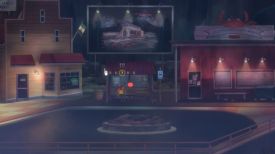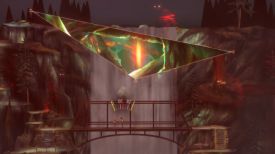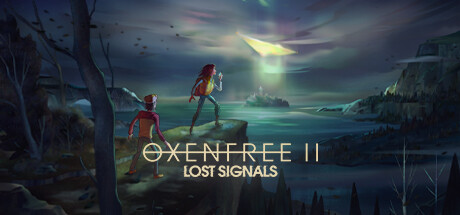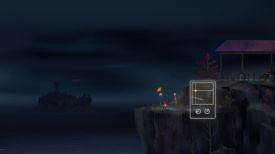|
By flotsam
Oxenfree II: Lost Signals
Night School Studio/Netflix
Five years later in game time and about eight years later in the real
world, we are back in Oxenfree. Or rather in Camena, from where the
protagonists of the first game set sail, and in which Riley finds
herself waking at a bus stop after a bit of glitchy weirdness. The
walkie-talkie has roused her, and Evelyn welcomes her to her first day
on the job. She fills Riley in on what that job is, something to do with
transmitters and disruptions in the electromagnetic spectrum. First
thing to do is get her gear from the General Store.
She soon encounters Jacob, who will be her companion throughout the
game. She knew him in High School, this being her old hometown, and
their interactions throughout the game is one of its strengths.
If
you played the first game you will know what to expect. There is a lot
that will be familiar in terms of the look and feel and how it all
works, plus some narrative linkages as well. That familiarity isnít
necessary though in order to enjoy about 8-10 hours of rambling across
the island, running across and then into some distinctly supernatural
goings-on.
Like the earlier game, conversations are a big part of Lost Signals,
developing both the broader story itself and the backgrounds of the
characters. Quite a few of them occur via your walkie-talkie, and you
can be as loquacious as it suits you. Use the walkie-talkie to regularly
check in on people or just answer it when it squawks (or perhaps not
even then), chat with Jacob or cut him short, be terse or charming or
donít answer at all; its up to you.
I
liked this aspect, and while a couple of times I had to stand around
waiting for Jacob to finish his story, I generally felt in control. The
dialogue is well written, exceptionally well acted, and puts a lot of
meat on the bones of your experience. Riley generally has three dialogue
options available to her when having a conversation, presented in little
speech bubbles above her head. Choose one, or donít choose any and drive
things as suits you. Importantly, each possible response felt
contextually valid, like something Riley (or your construct of Riley)
might say.
Riley and Jacob are older than the teenage characters we played in the
earlier game, a point of difference that allows for a whole bunch of
different stuff to be canvassed as they traverse the island. You
exclusively play Riley, but might be following Jacob or leading the way,
depending. Use the WASD keys to get around, or point and click, an added
(at least as far as I can recall) element that means you can watch as
Riley rappels and jumps and climbs her way from here to there, rather
than doing it yourself.
I
confess I liked the use of keyboard (there is no timing or actiony-ness
involved; interacting with the icon will have her perform the necessary
action) as it felt like it gave me more engagement with the
side-scrolling zoomed out perspective. Having said that, there were
times when rather than e.g., maneuver her up a cliff face, I just
clicked the top and let her do her own thing.
As
well as a walkie-talkie, which is only a mouse click away, you also have
a radio, used to tune into various frequencies and which is involved in
much of the puzzling. Open and close portals, unlock Ďradioí locks, or
perhaps just listen and learn stuff. I doubt I got the full use possible
out of either the radio or the walkie-talkie, despite spending a fair
bit of time using both.
I
did think the rather random nature of just twiddling a dial to solve
some puzzles left a bit to be desired (especially once you get the
expanded radio and have so many more frequencies available), but it was
a small thing in the overall scheme of things.
You have a map which will help you get around the island, and which will
show the exits from each scene (i.e., the points at which the scene will
stop moving around as you explore and a new one will load). It will also
generate an autosave, useful to know as you canít save manually. A
notebook attached to the map keeps track of certain things. They are
again just a mouse click away.
There is no inventory, although you will acquire things, ropes being
among the most useful (and never ending). At some point through the game
collectibles become available, letters you can find that will further
add to the tale.
Finding the letters isnít compulsory, nor is doing a number of tasks you
might come across. There will be a point near the end of the game though
where you will be told that if there are things that you still need/want
to do, do them now. That is your cue for e.g., finding the rest of the
letters or perhaps retrieving that blue backpack you didnít bother
looking for at the time. Again its entirely up to you but what you canít
do is come back once you pass that point and fill in any Ďgapsí in your
endeavours.
The broader tale is a spooky-tinged one, involving spirits and lost
submariners, visions and portals, a strange religious group and some
angsty teenagers. It provided a good counterpoint to what emerges
through the conversations between Riley and Jacob, the details of their
lives and their regrets and their hopes. As the prime character we get
to know a whole lot more about Riley, and I confess to liking her rather
a lot.
The choices you make throughout the game and the relationships you
develop Ė were you nice to that person in your earlier interaction? Ė
affect how things play out. I also saved one person (and got a Steam
trophy for doing so) and perhaps brought Nick home safely (would he have
made it back anyway?). The endgame comes with a big choice, one that
suggests there are three different endings. Regrettably you canít just
go back and make a different choice to see how things play out. All you
can do is start again, which I will do, but it would have been nice to
have the option of winding things back to that particular point.
There is a bit of time travelling plus some other inter-dimensional
experiences, and the soundtrack lives up to its task. It looks good, in
a watery coloured sort of way, and is similar enough and yet
sufficiently different to the first game to satisfy those that want more
of the same and those that like something else. As always, you might
feel differently, but for me there is a lot to like in these Lost
Signals.
I played on:
OS: Windows
10, 64 Bit
Processor:
Intel i7-9700K 3.7GHz
RAM: Corsair
Dominator Platinum RGB DDR4 32GB
Video card:
AMD Radeon RX 580 8192MB
GameBoomers Review Guidelines
August 2023
design copyright© 2023
GameBoomers
Group
 GB
Reviews Index GB
Reviews Index |






